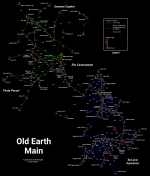Do you have a different map for NAFAL travel between the stars, or do you just disallow it completely?
The fuel rates in CT, MT, or MGT make NAFAL pretty much impossible without bending the minimum power plant rules.
Lets' look at a 1000 Td design, using Bk5 formulae... The minimum plant required is PP 1.
Td | MCr | Item | Rating |
1000 | 100 | Hull | |
20 | 500 | Bridge | |
10 | 15 | Maneuver | 1G |
30 | 90 | Powerplant TL 9 | 1 |
1 | 2 | Model 1 | 1 |
| | Crew 10 | P N E M C X AAA +1 |
40 | 5 | Staterooms ×10 | |
890 | 0 | Fuel | 89 months. = 6 years and 11 months imperial. |
9 | 0 | Payload | 9 tons cargo. |
| 712 | total | |
Note that one can pull that down - the average distance between stars is (per google) 5 LY... This is about the limit of a 1G hull.
Note also: the crew are getting majorly irradiated, unless one figures the (specified in Beltstrike) force field prevents interstellar medium from becoming abrasive.
Note that the drive will become pretty much dead by the end of year three...
why? Annual maintenance and the drive failure rule.
Weekly failure check: 13+, DM+1 if unrefined fuel, DM+1 per month past AM.
So... assuming refined fuel. Breaking out the HP calculator
| Months (13/year in canon) | Weekly Roll fail on | Cum chance of failure by end of month. | formula |
| 1 to 13¾ | no failure possible | | |
| 14 -- 14¾ | Nat 12 (1/36) | 10.66% | 1-{(35/36)^4} |
| 15 -- 15¾ | Nat 11+ (3/36) | 36.92% | 1-{((35/36)^4)*((33/36)^4)} |
| 16 -- 16¾ | Nat 10+ (6/36) | 69.58% | 1-{((35/36)^4)*((33/36)^4)*((30/36)^4)} |
| 17 -- 17¾ | Nat 9+ (10/36) | 91.72% | 1-{((35/36)^4)*((33/36)^4)*((30/36)^4)*((26/36)^4)} |
| 18 -- 18¾ | Nat 8+ (15/36) | 99.04% | 1-{((35/36)^4)*((33/36)^4)*((30/36)^4)*((26/36)^4)*((21/36)^4)} |
| 19 -- 19¾ | Nat 7+ (21/36) | 99.97% | 1-{((35/36)^4)*((33/36)^4)*((30/36)^4)*((26/36)^4)*((21/36)^4)*((15/36)^4)} |
So, by the end of year two, we're into winning the multistate powerball solo with a full match to all balls drawn.
Now... ways to tweak this...
If we assume a non-operating drive doesn't need annual maintenance (which I wouldn't normally concede), we can get 14 months per drive, at a penalty of 40 tons per set of spares. Being a pretty picayune rules monger, I'd also require the computer have a backup, same reason. So, 41 tons per year for semi-mothballed drives.
Oh, and those staterooms only include one month's food storage. Each ton of cargo is 2000 person days. 49 years worth. (Best of JTAS p 30)

